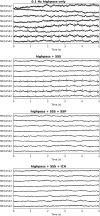Improving Localization Accuracy of Neural Sources by Pre-processing: Demonstration With Infant MEG Data
- PMID: 35401424
- PMCID: PMC8983818
- DOI: 10.3389/fneur.2022.827529
Improving Localization Accuracy of Neural Sources by Pre-processing: Demonstration With Infant MEG Data
Abstract
We discuss specific challenges and solutions in infant MEG, which is one of the most technically challenging areas of MEG studies. Our results can be generalized to a variety of challenging scenarios for MEG data acquisition, including clinical settings. We cover a wide range of steps in pre-processing, including movement compensation, suppression of magnetic interference from sources inside and outside the magnetically shielded room, suppression of specific physiological artifact components such as cardiac artifacts. In the assessment of the outcome of the pre-processing algorithms, we focus on comparing signal representation before and after pre-processing and discuss the importance of the different components of the main processing steps. We discuss the importance of taking the noise covariance structure into account in inverse modeling and present the proper treatment of the noise covariance matrix to accurately reflect the processing that was applied to the data. Using example cases, we investigate the level of source localization error before and after processing. One of our main findings is that statistical metrics of source reconstruction may erroneously indicate that the results are reliable even in cases where the data are severely distorted by head movements. As a consequence, we stress the importance of proper signal processing in infant MEG.
Keywords: artifact; brain; infant; magnetoencephalography (MEG); movement compensation; signal processing; signal space projection; signal space separation.
Copyright © 2022 Clarke, Larson, Peterson, McCloy, Bosseler and Taulu.
Conflict of interest statement
The authors declare that the research was conducted in the absence of any commercial or financial relationships that could be construed as a potential conflict of interest.
Figures






Similar articles
-
Extended Signal-Space Separation Method for Improved Interference Suppression in MEG.IEEE Trans Biomed Eng. 2021 Jul;68(7):2211-2221. doi: 10.1109/TBME.2020.3040373. Epub 2021 Jun 17. IEEE Trans Biomed Eng. 2021. PMID: 33232223 Free PMC article.
-
The Importance of Properly Compensating for Head Movements During MEG Acquisition Across Different Age Groups.Brain Topogr. 2017 Mar;30(2):172-181. doi: 10.1007/s10548-016-0523-1. Epub 2016 Sep 30. Brain Topogr. 2017. PMID: 27696246
-
Artifact and head movement compensation in MEG.Neurol Neurophysiol Neurosci. 2007 Oct 29:4. Neurol Neurophysiol Neurosci. 2007. PMID: 18066426
-
Recognizing and Correcting MEG Artifacts.J Clin Neurophysiol. 2020 Nov;37(6):508-517. doi: 10.1097/WNP.0000000000000699. J Clin Neurophysiol. 2020. PMID: 33165224 Review.
-
Magnetoencephalography for localizing and characterizing the epileptic focus.Handb Clin Neurol. 2019;160:203-214. doi: 10.1016/B978-0-444-64032-1.00013-8. Handb Clin Neurol. 2019. PMID: 31277848 Review.
Cited by
-
Pushing the boundaries of MEG based on optically pumped magnetometers towards early human life.Imaging Neurosci (Camb). 2025 Mar 13;3:imag_a_00489. doi: 10.1162/imag_a_00489. eCollection 2025. Imaging Neurosci (Camb). 2025. PMID: 40800963 Free PMC article.
-
Infant brain imaging using magnetoencephalography: Challenges, solutions, and best practices.Hum Brain Mapp. 2022 Aug 15;43(12):3609-3619. doi: 10.1002/hbm.25871. Epub 2022 Apr 16. Hum Brain Mapp. 2022. PMID: 35429095 Free PMC article.
-
Perspective: An outlook on fluorescence tracking.ArXiv [Preprint]. 2025 Aug 19:arXiv:2508.13668v1. ArXiv. 2025. PMID: 40895082 Free PMC article. Preprint.
References
-
- Medvedovsky M, Taulu S, Bikmullina R, Paetau R. Artifact and head movement compensation in MEG. Neurol Neurophysiol Neurosci. (2007) 4:1–10. - PubMed
-
- Taulu S, Kajola M. Presentation of electromagnetic multichannel data: the signal space separation method. J Appl Phys. (2005) 97:124905. 10.1063/1.1935742 - DOI
LinkOut - more resources
Full Text Sources
Research Materials

